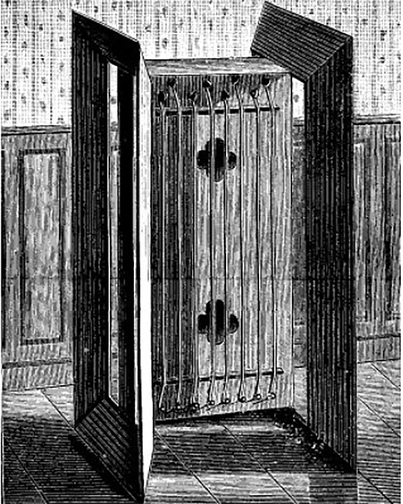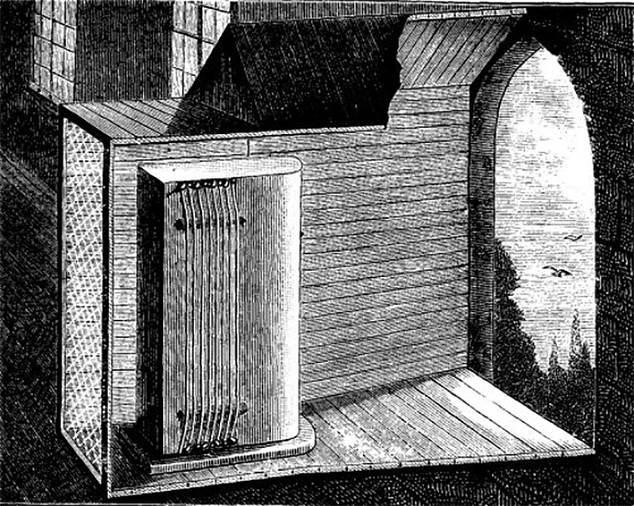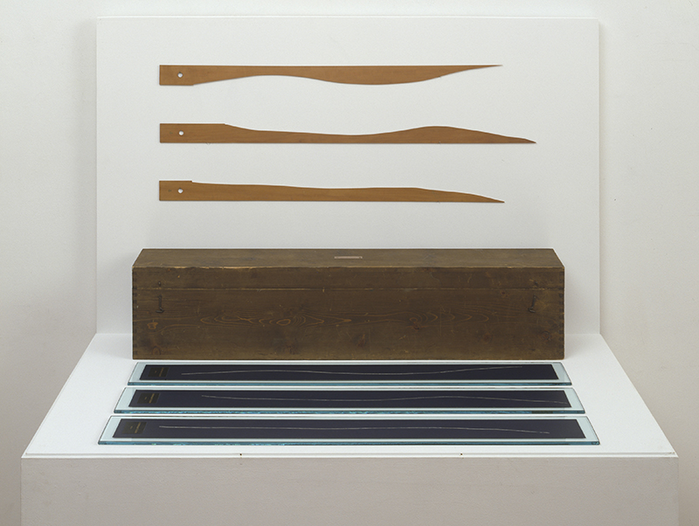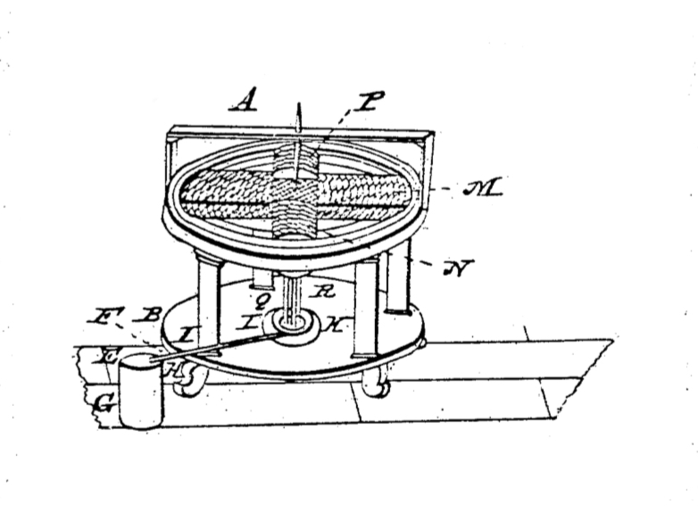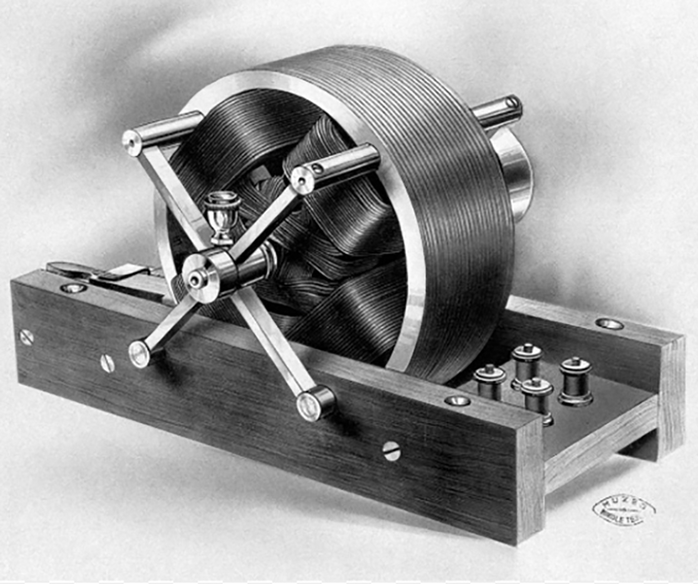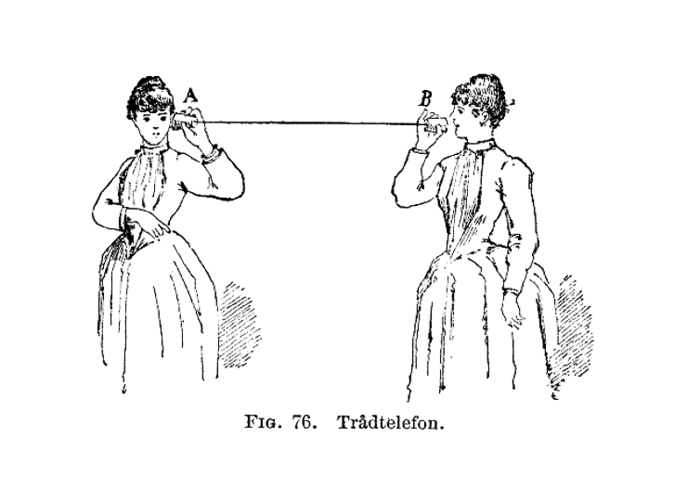Performance, Acoustics, Optics
Sound artist and theorist Brandon LaBelle sees two key currents shaping the landscape of twentieth century sound art: one stemming from the studio experiments of Schaeffer, the other from the performances and compositions of John Cage. Where the former conceives of sound as an object, the latter is alert to the resonances of physical things; if in the first the emphasis is on technical expertise, physics and acoustics, minimizing contexts, in the second, it is the performativity of materials and audiences, prioritizing contexts, that take center stage (LaBelle 2006: 24-25 and 32-33). Given Duchamp’s friendship and interactions with Cage, much of the scholarship on the artist’s thinking about sound has been correlated with Cage’s materialist and socially-attuned perspectives;[15] these should be turned to for access to the next layers of With Hidden Noise.
If With Hidden Noise is a device harboring a sound object, this noise nevertheless requires activation. In this light, its acoustic potentials signal that the work might be considered as much performative as it is visual, conceptual or contemplative, at least by participants around and after its genesis on New Year’s Eve 1916 chez Arensberg. According to Duchamp’s often-cited statement of 1957 “The Creative Act,” any artwork is in fact just one corner of a triangulation between artist, artwork and spectator. But if this spectator effectively completes the work through his or her interpretative contribution, here this audience member might in principle also become both listener and activator: a participant musician. (Duchamp seems to have already accounted for this in claiming that “the creative act is not performed by the artist alone” [Duchamp [1957] 1975: 140, my emphasis]). Without this intervention, indeed, this is one work that never quite manages to re-stage its completedness for successive generations of observers, since originally the activation of With Hidden Noise relied on its location not in a gallery but in a private collection and a domestic space.
As a sound-generating object or machine, With Hidden Noise is in this sense not just a sculpture but an invitation, an instrument. Robert Lebel, for example, in a comparison that rubs a little awkwardly against Duchamp’s customary preoccupations but that the two friends might well have discussed in conversation, reads the work as “a typical magical noise-maker like the churinga or bull-roarer of the Australian aborigine” (1959: 39). We certainly know that around late 1915 and early 1916 Duchamp was thinking of relationships between object, space and sound – of an object as one step away from an instrument – in the context of the work immediately preceding With Hidden Noise, Comb of 1916, which a note from the Green Box links to the idea of a rattle. Asked by Arturo Schwarz to elucidate this insight – after all, a metal comb doesn't normally rattle, though presumably its teeth might be “zipped” with a finger, or it might be played using the traditional method of wrapping it in paper and humming through it – Duchamp replied “Well, the Rattle is a toy for children that makes noise when you turn it, and the comb becomes a generator of space, space generated by teeth.”[16] At a primitive level, With Hidden Noise can certainly be considered as a makeshift rattle, one that, of course, combines a traditional musician’s activations with acousmatic listening, since a rattle’s noise source is usually hidden.
It is tempting along these lines to re-think Duchamp’s repeated use of string and wire as speculative experiments with plucked or percussive instruments, as sound-making objects that might resonate aurally as well as intellectually: the chirruping spokes of Bicycle Wheel;[17] the stringed and wired mechanisms of the Large Glass and its related studies; and the pianissimo cacophony of the huge acoustic instrument to be plucked by the visitor that is the “mile of string” – Duchamp’s irreverent winding of twine around and against the exhibition First Papers of Surrealism of 1942, in which audience members become the musicians of a space turned into a music box.[18] In particular, this invites us to read the playful mathematics of Three Standard Stoppages of 1913 (Fig. 3) – in which the chance-derived configurations of three identical one-meter lengths of string are used to destabilize the logic of measurement and geometry – as the beginnings of an investigation into the pitch and timbre of a stringed instrument, in the same way that the strings of a violin or guitar are all the same length but produce different notes when “stopped” against a fingerboard. The resultant curves, made into wooden templates, in turn resemble diagrams of sinusoidal sound waves and their complex harmonics. While this suggests ways in which we might read the work as performative and aural, on at least one occasion Duchamp presented it not only in the context of sound but linked this idea of noise to the notion of meaning and delayed or deferred knowledge – in other words, to the resonances of the unsound. In a late interview with Katherine Kuh, Duchamp offered this perspective on Three Standard Stoppages:
In itself it was not an important work of art, but for me it opened the way – the way to escape from those traditional methods of expression long associated with art. I didn't realize at that time exactly what I had stumbled on. When you tap something, you don't always recognize the sound. That's apt to come later. For me the Three Stoppages was a first gesture liberating me from the past. (Judovitz 1998: 35)
Questions of sound, then, are connected to matters of time, and what might be ventured as the “sonic turn” of Duchamp’s work can be seen in the light of his concern with temporality and duration. This is close to what Schaeffer specifies when he compares visual (material) objects and aural objects: “sound objects, unlike visual objects, exist in duration, not in space: their physical medium is essentially an energetic event occurring in time” (2017: 190). In this sense, Duchamp’s attention to duration and “delay” (a word that in recording studio parlance is also the technical term for an audio echo) is part of his strategy for weakening the reign of the visual over the phenomenology of space.
Casey O’Callaghan, a philosopher interested in perception, has set out the distinctions between vision and audition with the problem of the conception of “auditory objects” in mind. He emphasizes their disembodied condition, in that “auditory experience presents sounds as independent from ordinary material things, in a way that visual and tactual features are not” (2008: 804), something emphasized in With Hidden Noise, since the source of the sound is doubly hidden – from view and from memory. More particularly, the distinction between visual and auditory objects, O’Callaghan argues, is that, while auditory forms lack the spatial boundaries and the material opacity of visual objects, what they possess instead is the quality of unfolding, of occurrence: sounds “furnish information about the events and happenings – the collisions, vibrations and interactions – that commonly make or produce sounds. [They] do not concern the relatively static material objects that exist at a time; they engage the ongoing activities and transactions in which such objects engage” (2008: 824). This temporal quality seems activated and targeted by several aspects of With Hidden Noise: the moment of its secret completion by Arensberg, the friends’ performances that would have ensued, and its latent re-activation by every contemporary viewer posing as a listener.
Exchanges between the visual and the aural are found everywhere in Duchamp’s work; Adcock for one (1992: 130) makes the claim that his initiation of such a dialogue specifically harnesses sound in order to critique visual conventions. This conversation might go both ways. It is tempting to see Duchamp’s interest in optics – present notably in the Large Glass and studies; in the later experiments of the Rotoreliefs, harnessed to the rotating mechanism of the phonograph; and the doubtless noiseful optical machines of the 1920s, all of these being also investigations into multi-dimensionality – as a “referred” interest in acoustics, like a referred pain caused in one place but experienced in another. To use a term that has several times been applied to Duchamp’s conceptual strategies, the optical and the acoustic are “in resonance” with each other, with ideas and forms from one domain echoed and triggered in the other to fertile but often subtle effect. An acoustic resonance, as with the hollow body of a violin or guitar, requires space, an interval that is also at one level the chamber in which the wider questions about the status of art practice can be rehearsed. As Duchamp noted in conversation with Schwarz, “It’s not what you see that is art, art is the gap” (in Judovitz 1998: 35). Once again, the artwork’s presence is figured both as an absence (a silence, or a hidden signal) and as the space between art and nonart that makes resonance possible.
In this spirit of resonance we might pause to note the existence of several cousins to Duchamp’s string instruments lying latent within his practice, though I am not trying to suggest that the artist had them specifically in mind. The first, with reference back to With Hidden Noise’s status as a coiled contraption, is the more general link between this work and its associations with stringed mechanisms – objects that usually make a conspicuous amount of noise. These might include looms and the machinery of the production of cordage (an industry in which he was later to take more of an interest),[19] but also electric motors and transformers featuring a central armature wound with wire (Figs 4 and 5). Duchamp already makes an explicit link between coils and motion in his Chocolate Grinder, whose grinding stones are strung with lead wire in place of the grooves they would normally have. Wire coils are also, however, at the heart of several sonic devices developed in the same era as With Hidden Noise, such as moving coil microphones and hearing aids. The next is the “tin can telephone,” a primitive communication device first tested experimentally by Robert Hooke in the 1660s and known to children around the world: two resonating containers are joined by a piece of string which, when kept taut, can transmit sound from one to the other (Fig. 6). Known in the nineteenth century as the “lovers’ phone,” the suggestion of acoustic communication where sound (or unsound) equates with meaning along string or wire finds echoes in the Large Glass, in which the tentative lines connecting male and female zones (the filament-like “toboggan” and “handler of gravity” that might after all have opened the line of communication between bride and bachelors) figure those elements that Duchamp forbore to complete.
The third is that enigmatic, satisfyingly Rousselian machine, the aeolian harp. An instrument without a musician, the harp is made from a resonating box set so as to be played by the wind. Known in the ancient world, the instrument was first described by Athanasius Kircher in his Phonurgia nova (1673), in which we note that the author also makes analogies between sound and light, since this treatise argues that the laws of acoustics can be derived from those of optics.[20] Usually placed on a tree or building, the Aeolian harp is also to be set by an open window, and period images of such harps – for example, Kircher’s seventeenth century harp or the instrument installed at Baden Baden castle, reproduced in a Scientific American Supplement of 1885-6 (Figs. 7-9) – shows the machine in direct configuration with an open window, in phase with the Large Glass’s status as both window and door.[21] While there is no suggestion that Duchamp had this instrument in view, several reverberations are noteworthy: between the rectangular wooden case of the harp and that used to house the unsound strings of Three Standard Stoppages; the repeated use of “resonating boxes” that characterize his archiving and curation of his own practice; the wafting Draft Pistons of 1914; or the geometry book, strung up and left to flutter in the wind, that was Unhappy Readymade of 1919, along with its parent Sculpture de Voyage of the previous year, in which rubber strips were stretched across the artist’s New York studio.[22]
Figs 7-9. Kircher’s Aeolian harp; Frost and Kastner’s improved Aeolian harp; Aeolian harp in the old castle of Baden Baden. Scientific American supplement No. 483, April 1885. Source: Project Gutenberg.
Fig. 3. Marcel Duchamp, 3 stoppages étalon (3 Standard Stoppages), 1913-4, replica 1964. Dimensions variable.
Wood, glass and paint on canvas. Tate gallery. © Association Marcel Duchamp / ADAGP, Paris and DACS, London 2020.
Figs 4 and 5. Thomas Davenport's patented electric motor, 1837. Image courtesy of Karlsruhe Institute of Technology. Nikola Tesla, electric induction motor, 1888. Source: public domain via www.cleanpng.com.


